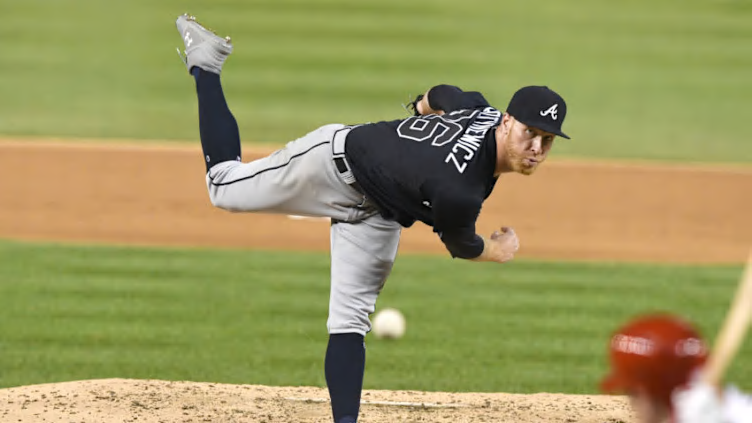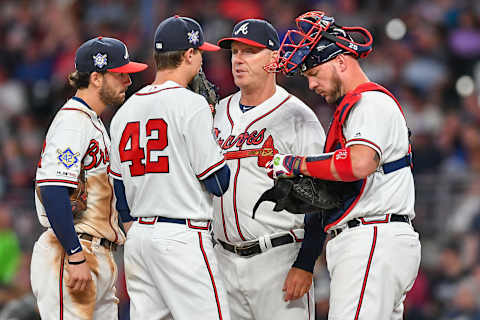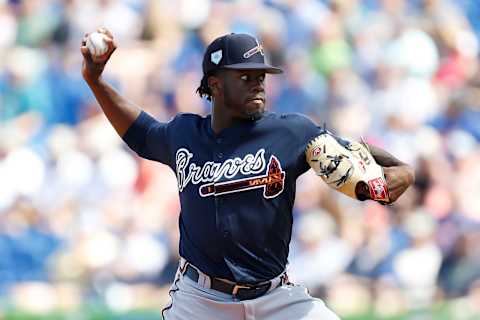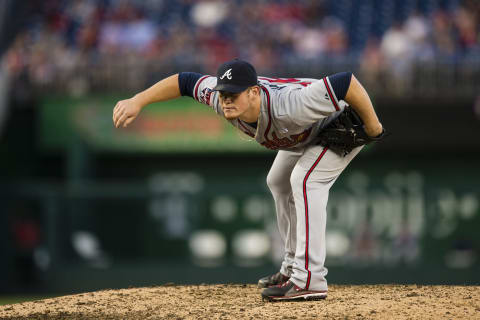Atlanta Braves: THE Solution for Fixing the 2019 Pitching Staff


After 16 games played in the 2019 MLB season, it is clear that the Atlanta Braves have one glaring weakness – the bullpen.
The first ten percent of the baseball season has flown by, and the Atlanta Braves find themselves comfortably in the mix of what is already proving to be a competitive race in the NL East. With a run differential so far of +12 runs, the club is performing as expected from an analytics perspective with a record of 9-7.
Extrapolated out over the course of 162 games, the Braves are on pace for 91-92 wins. Sounds good, right?
The Braves are on a run where they are scoring 5.5 runs a game. During this stretch, the starting pitching has pitched decent enough, with a combined ERA of 4.20.
This includes outlier starts such as Julio Teheran’s outing in Colorado where he dominated for 4 innings and imploded with a 6 run 5th inning. It also includes starts by rookies Kyle Wright and Bryse Wilson who were initial placeholders for injured starters Mike Foltynewicz and Kevin Gausman. Wright, Wilson, and Sean Newcomb are no longer with the MLB club, and Foltynewicz should be back soon to fortify a solid starting rotation.
The one real weakness of the team, so far, is one that was predicted by many fans and analysts throughout the offseason. The Atlanta Braves front office decided, for whatever reason, to not address a unit that struggled mightily throughout the second half of last season.

Leaky Pen
So far in 2019, the Atlanta Braves bullpen as a group has completed 59 2/3 innings as compared to the starters’ 81 1/3 innings pitched. In 21 1/3 fewer innings pitched, the pen has given up just 2 fewer earned runs, walked just 3 fewer batters, and has given up 2 more home runs than their starting counterparts. Overall, the bullpen ERA is currently 5.43.
In trying to protect late-inning leads, the reserves have already blown 3 saves while converting just 2. While these numbers are mind-numbingly bad, they are actually helped by Touki Toussaint’s emergency relief appearance on Saturday where he took over for Newcomb in the 2nd inning and pitched 6 scoreless innings. Toussaint will start for the club later this week.
Coming into the season, the Braves’ pitching staff was expected to be one giant puzzle that required a bit of sorting and arranging of the pieces to find the appropriate combination for a successful season.
With Foltynewicz, Gausman, and Teheran serving as the experienced nucleus of the starting staff, the Braves also expected to feature a young group of starters potentially including Newcomb, Wright, Toussaint, Wilson, Max Fried, Mike Soroka, Luiz Gohara, and Kolby Allard. Each of these guys has already started multiple games at the Major League level. And if you want to get crazy, they also have Patrick Weigel and Huascar Ynoa waiting in the wings and rounding out the 40-man roster.
With the embarrassment of riches that the Braves possess in starting pitchers comes a few issues. The first is obvious. They have 11-13 pitchers and only 5-6 spots on the Major League roster.
The second is in regards to inning limits. Gone are the days of 200 inning pitchers filling the starting rotations at the MLB level. Teams are careful with young pitchers’ workloads and ideally would like to see their IPs gradually increase over the course of several seasons.
Julio Teheran has consistently gone 180+ IP for the duration of his career, but even veterans like Gausman and Foltynewicz have only had three seasons of 180+ IP between the two of them.
Finally, the Braves have had a hard time finding guys who can pitch efficiently enough to routinely go 6+ innings per start.
As deep as the starting pitching is for Atlanta, the bullpen is equally void of answers. To conquer a stacked NL East in 2019, the Atlanta Braves must find a way to overcome this disadvantage, and I can see only two real options to fix this mess of a bullpen:
- trade minor league assets in a series of deals to fortify the pen, or
- get creative.
Option #1 is both undesirable and extremely difficult to accomplish. First, it is too early in the season to find trade partners willing to give up productive bullpen arms. Secondly, the club would be foolhardy to jettison prized prospects to fill holes in the bullpen unless they are used to acquire a top-flight closer with multiple years left on his contract.
That brings us to option #2. It’s time for the Braves to get creative and my proposal would, in theory, solve each and every one of the problems outlined in the previous paragraphs. In fact, I would even be willing to offer my services to the Braves as a consultant for a fraction of the price that it would cost to bring in someone who actually knows what he’s doing.

A solution to THE problem
If I were the Braves’ General Manager for a day, I would structure my 13-man pitching staff as follows:
More from Call to the Pen
- Philadelphia Phillies, ready for a stretch run, bomb St. Louis Cardinals
- Philadelphia Phillies: The 4 players on the franchise’s Mount Rushmore
- Boston Red Sox fans should be upset over Mookie Betts’ comment
- Analyzing the Boston Red Sox trade for Dave Henderson and Spike Owen
- 2023 MLB postseason likely to have a strange look without Yankees, Red Sox, Cardinals
- Sign Craig Kimbrel and give him whatever he wants
- Carry 10 starting pitchers and 3 relievers
- Assign a designation of “Group A” and “Group B” to the starters
- Strategically pair one “A” starter with one “B” starter for each game
- Pitch my “A” starter a max of 5 innings per start and my “B” starter 3-4 innings per game
Like anything, this outline could be flexible based on matchups, health, or the day-to-day performance of each pitcher, but in a perfect world my proposal would look something like this:
Game 1: A – Foltynewicz (R) B – Newcomb (L)
Game 2: A – Gausman (R) B – Gohara (L)
Game 3: A – Fried (L) B – Toussaint (R)
Game 4: A – Teheran (R) B – Allard (L)
Game 5: A – Soroka (R) B – Wright (R)
Wash, rinse, repeat.
With 3 spots on the pitching staff left, I would roll with Kimbrel, AJ Minter, and Arodys Vizcaino as my closer and mid-inning damage control stoppers.
With this proposal, the Atlanta Braves address the backlog of uber-talented starting pitchers in the system while allowing them to control the innings pitched of each pitcher. Additionally, rather than fighting the trend starters only going 5 innings per start, they can embrace this and comfortably allow their pitchers to go max effort in shorter stints. And finally, it enables the club to purge the weak links from the roster and compete with their best combination of 13 pitchers.
With teams beginning to embrace changes such as Tampa Bay’s “opener” (relief pitchers starting games and going 1-2 innings) and Milwaukee’s multi-inning shutdown reliever (Josh Hader pitched 81 innings in 55 games and finished 7th in the Cy Young voting last season), it’s only a matter of time before a team experiments with something similar to my proposal.
The key difference is that the 2019 Atlanta Braves have the resources, depth, talent, and the perfect set of circumstances where this strategy makes complete sense.
Tampa Bay Rays: Blake Snell’s unlikely mishap lands him on IL. dark. Next
As any fan undoubtedly believes…if the Braves would listen to me, there would be no stopping them.